
 |
|
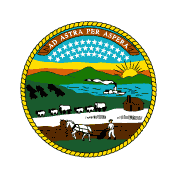













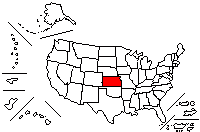
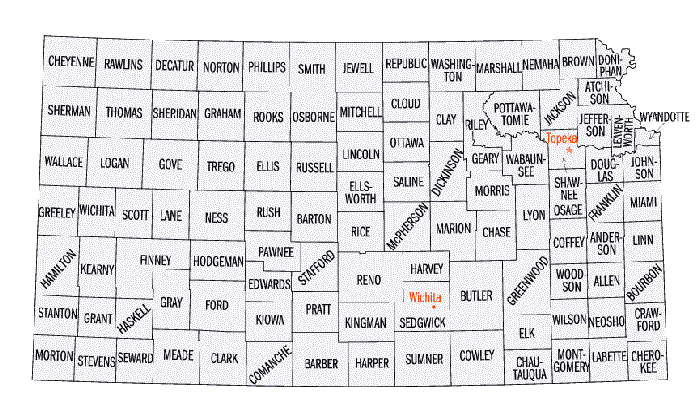

Home on the Range |
Hogar en la Cordillera |

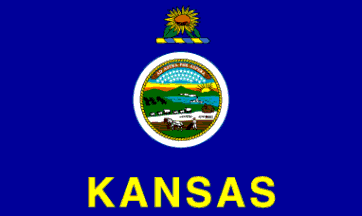
Flag:
On a navy blue field is a sunflower,
the state flower. Also, the state seal and the words "Kansas".
In the picture of the state seal are thirty-four stars representing
the order of statehood. Above the stars is the motto "To the Stars Through Difficulties".
On the seal a sunrise overshadows a farmer plowing a field near his log cabin, a
steamboat sailing the Kansas River, a wagontrain heading west and Native Americans
hunting bison. Flag adopted 1927.
Bandera:
En el fondo azul marino hay un girasol, la flor del estado. También, aparece el sello del
estado con las palabras "Kansas".
En la foto del sello hay treinta y cuatro estrellas representando la orden de la estadidad.
Sobre las estrellas está el lema" A la estrella atravesando las dificultades".
En el sello un amanecer eclipsa a un granjero que está arando el campo cerca de su cabaña,
una embarcación de vapor navegando en el Río Kansas, una carabana dirigiendose al oeste
y un Nativo Americano cazando un bisonte. Bandera fué adoptado en el 1927.

Kansas
Capital City: Topeka
National: Kansans
Admission to Statehood: January 29, 1861
Motto: Ad astra per aspera -
To the stars through difficulties
John J. Ingalls was responsible for including this
motto in the design of the great seal in 1861. He was at the time secretary of the Senate.
Ingalls claimed the phrase was “as old as Josephus,” quite common in heraldry.
He had first noticed it in the office of the gentleman under whom he had read law.
Nickname: Sunflower State
Origin of state's name: Named by USA citizens. From the Sioux Indian for "south wind people"
Kansas (se pronuncia Kán-zas en inglés)(Kán-sas en español)
Ciudad Capital: Topeka (se pronuncia tou-pí-ka en inglés)(To-pé-ka en español)
Gentilicio: Kanseños
Admición como estado: 29 de enero de 1861
Lema: Ad astra per aspera - A las Estrellas atravesando de las dificultades
John J. Ingalls
fué el responzable de incluir este lema en el diseño del gran sello en el 1861. Para ese
tiempo él era el secretario del Senado. Ingalls reclamó que la frase fuera "Tan antiguo como
Josefus" frase común en las hiladicas.
Cognómento: El Estado del Girasol
Origen del nombre: Nombre dado por ciudadanos americanos. Viene del lenguaje indio Sioux que significa "Personas del viento del Sur".

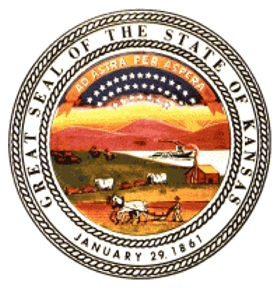
The Seal:
On May 25, 1861, the Kansas State Legislature adopted the state's seal. Per that resolution,
the Great Seal of the State of Kansas would have this design: The east is represented by a
rising sun in the right-hand corner of the seal; to the left of it, commerce is represented
by a river and a steamboat; in the foreground, agriculture is represented as the basis of
the future prosperity of the state by a settler's cabin and a man plowing with a pair of
horses; beyond this is a train of ox-wagons going west; in the background is a herd of
buffalo, retreating, pursued by two Indians on horseback; around the top is the motto,
"Ad astra per aspera," and beneath a cluster of thirty-four stars. The circle is surrounded
by the words, "Great Seal of the State of Kansas January 29, 1861."
The words "Ad astra per aspera," are the the state's motto, meaning "To the stars
through difficulties". The 34 stars identify Kansas as the 34th state to enter the Union.
El Sello
El 25 de mayo de 1861 la Legislatura del Estado de Kansas adoptó un Sello Estatal. Por ese resolución
el Gran Sello del Estado de Kansas tendría este diseño: El este está representado por un
amanecer in la mano derecha de la esquina del sello; a la izquierda, el comercio está representado
por un río y una embarcación a vapor; en el fondo, la agricultura está representada como la
base del futuro prospero del estado por una cabaña y un hombre arando won un par de caballos;
más allá está una carabana de bagones dirigiendose al oeste; más al fondo está una manada de
bufalos perseguidos por dos indios a caballo; al rededor del borde de arriba está el lema,
"Ad astra per aspera," y debajo un grupo de cuarenta y cuatro estrellas. El cículo está rodeado
por las palabras, "Gran Sello del Estado de Kansas 29 de enero de 1861."

HISTORY
Occupying the central position in the conterminous United States,
Kansas is one of the nation's leading agricultural states.
It is 15th in size among the states. Kansas is bordered by Nebraska,
Missouri, Oklahoma, and Colorado. The area was first explored by
Europeans with the Coronado expedition of 1541, but significant Anglo
settlement did not occur until 1855. After a six-year struggle over
the slavery issue, the "Sunflower State" entered the Union in 1861
on the free side. Today it is a prosperous, conservative, rural
state with an economy well balanced between agriculture and industry.
Topeka is the capital. The name Kansas is a Sioux word
meaning "people of the south wind."
When Francisco Vasquez de Coronado explored the area in 1541,
Kansas was occupied primarily by Osage, Pawnee, and Kansa peoples.
A Pueblo group, fleeing Spanish rule in New Mexico, occupied a
site in western Kansas from about 1664 until 1730.
(The Pueblo site and a Pawnee village in northern Kansas have
now been restored.)
Kansas was part of the area claimed by France as Louisiana at
the end of the 17th century. It was ceded to Spain in 1762,
restored to France in 1800, and sold to the United States in
1803 in the Louisiana Purchase. Many of the famous expeditions
to the West in the early 19th century passed through Kansas,
including those of Zebulon Montgomery Pike in 1806 and Stephen H.
Long in 1819-20. Reports from the Long party led to the erroneous
use of the term "Great American Desert" to describe the plains region.
Primarily because of this image, Kansas was considered an unlikely
place for Anglo settlement, and the government decided to use the
land for reservations for displaced Indians from the East.
Westward-bound migrants were passing through Kansas, however,
on both the Oregon Trail and the Santa Fe Trail. Soon tremendous
pressure developed to open Kansas itself for settlement,
and in the early 1850s the Indians were moved to what became
Oklahoma. Three small reservations in northeast Kansas are relics
from that earlier time: the Potawatomi, the Kickapoo, and the
Iowa-Sac-Fox.
The U.S. government opened Kansas to settlement in 1854 under the
terms of the Kansas-Nebraska Act, which allowed the territory
to determine its own position on slavery. The peopling of Kansas
thus immediately became a national issue. Organizations like the
Emigrant Aid Company promoted immigration by antislavery
Northerners, while proslavery groups mounted a similar drive.
The two groups of settlers established rival governments,
violence erupted, and the territory soon became known as
"bleeding Kansas." After much controversy within both the
territory and the U.S. Congress, the proposed proslavery
Lecompton (Drafted in
October-November 1857 at Lecompton,
capital of the Kansas Territory, the Lecompton Constitution was designed to bring Kansas
into the United States as a slave state)
Constitution was rejected by the electorate,
and Kansas entered the Union in 1861 under the terms of
the Wyandotte Constitution (1859). Guerrilla raids continued
along the Missouri-Kansas border throughout the Civil War.
A major land boom occurred in the 1870s, as adequate rainfall,
good soil, postwar mobility, and rapidly expanding railroads
brought thousands to the state, including many immigrants from
Germany, Sweden, Russia, and elsewhere. One group, the
German-Russian Mennonites, introduced the hard winter wheat
that transformed Kansas agriculture.
Ocupando la posición central en los Estados Unidos,
Kansas es uno de los estados agrícolas líder de la nación.
Es décimo quinto de tamaño entre los estados. Kansas es rodeado
por Nebraska, Missouri, Oklahoma, y Colorado. El área primero fue
explorada por europeo con la expedición de Coronado de 1541, pero el
establecimiento significativo de Anglo no ocurrió hasta 1855.
Después de que una lucha de seis años sobre el asunto de la
esclavitud, el " estado del girasol " entró a la unión en 1861
al lado abolicionista. Es hoy un estado con una economía bien equilibrada
entre la agricultura y la industria. Topeka es la capital. Kansas es una palabra
Sioux que significa "gente del viento del sur."
Francisco Vasquez de Coronado exploró el área en
1541, Kansas fue ocupada sobre todo por Osage, Pawnee,
y personas de Kansa. Un grupo de los indios Pueblo, queríab huir del
régimen español en Nuevo México, ocupó un sitio en Kansas occidental de cerca de 1664 hasta
1730. (el sitio de Pueblo y una aldea de Pawnee en Kansas norteño
ahora se han restaurado.) Kansas era parte del área reclamada por
Francia como Luisiana en el final del 17mo siglo. Fue cedido a
España en 1762, regresado a Francia en 1800, y vendido a los Estados
Unidos en 1803 en la compra de Luisiana. Muchas de las expediciones
famosas al oeste en el diecinueveavo siglo temprano pasaron a través
de Kansas, incluyendo los de Zebulon Montgomery Pike en 1806 y de
Stephen H.
Long en 1819-20. Los informes del partido de Long
condujeron al uso erróneo del término " gran desierto americano " de
describir la región de los llanos. Sobre todo debido a esta imagen,
Kansas era considerado un lugar inverosímil para el establecimiento
del Anglo, y el gobierno decidido utilizar la tierra para las
reservaciones para los indios desplazados del este. Que va hacia el
oeste-limite a nómadas pasaban a través de Kansas, como en
Oregon y Santa Fé.
Pronto la enorme presión
desarrollada para abrir Kansas a sí mismo para el
establecimiento, y en el 1850s los indios fueron movidos a lo que
se convirtió en Oklahoma. Tres reservaciones pequeñas en Kansas
nordestal son reliquias a partir de ese tiempo anterior: el
Potawatomi, el Kickapoo, y el Iowa-Sac-Fox. El gobierno de ESTADOS
UNIDOS abrió Kansas para ser establecido en 1854 bajo términos del
acto de Kansas-Nebraska, que permitió que el territorio determinara
su propia posición respecto a esclavitud. El poblar de Kansas se
convirtió en inmediatamente necesidad nacional. Las
organizaciones como el Emigrant Aid Company promovieron la
inmigración por los antiesclavistas norteños, mientras que los grupos
pro esclavistas tomaron un impulso similar. Los dos grupos de
colonos establecieron gobiernos rivales, violencia entrada en
erupción, y el territorio pronto se conosería como " sanguienta Kansas."
Después de mucha controversia dentro del territorio y del congreso de
ESTADOS UNIDOS, la constitución propuesta por el proesclavista Lecompton
(bosquejado en October-November 1857 en Lecompton, la capital del
territorio de Kansas, la constitución de Lecompton fue diseñado para
traer Kansas en los Estados Unidos como estado esclavista)
fué rechazada por el electorado, y Kansas entró a la unión en 1861
bajo términos de la constitución de Wyandotte (1859). Las
incursiones de la guerrilla continuaron a lo largo de la frontera de
Missouri-Kansas a través de la guerra civil. Un auge importante de
la tierra ocurrió en el 1870s, como precipitación adecuada, el buen
suelo, la movilidad de la posguerra, y ferrocarriles rápidamente que
se ampliaban atrayendo millares al estado, incluyendo muchos
inmigrantes de Alemania, Suecia, Rusia, y a otra parte. Un grupo, el
menonitas ruso-alemán, introdujo el trigo de invierno duro que
transformó la agricultura de Kansas.
